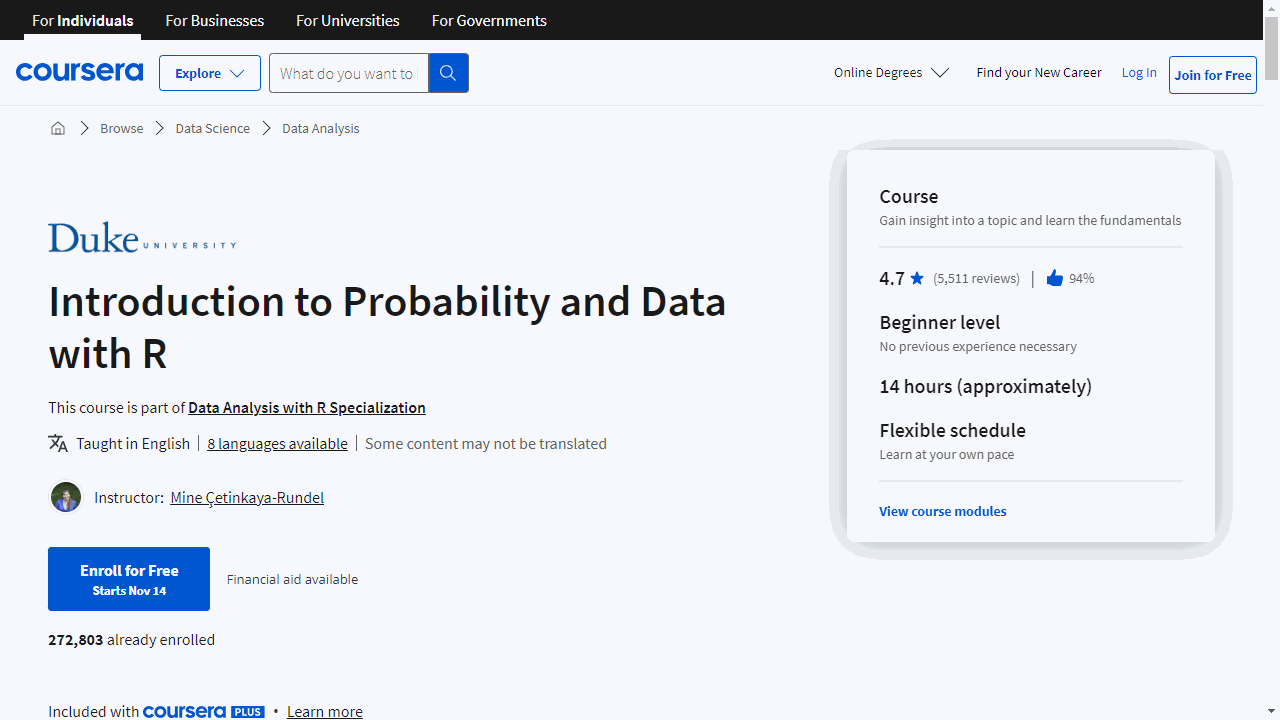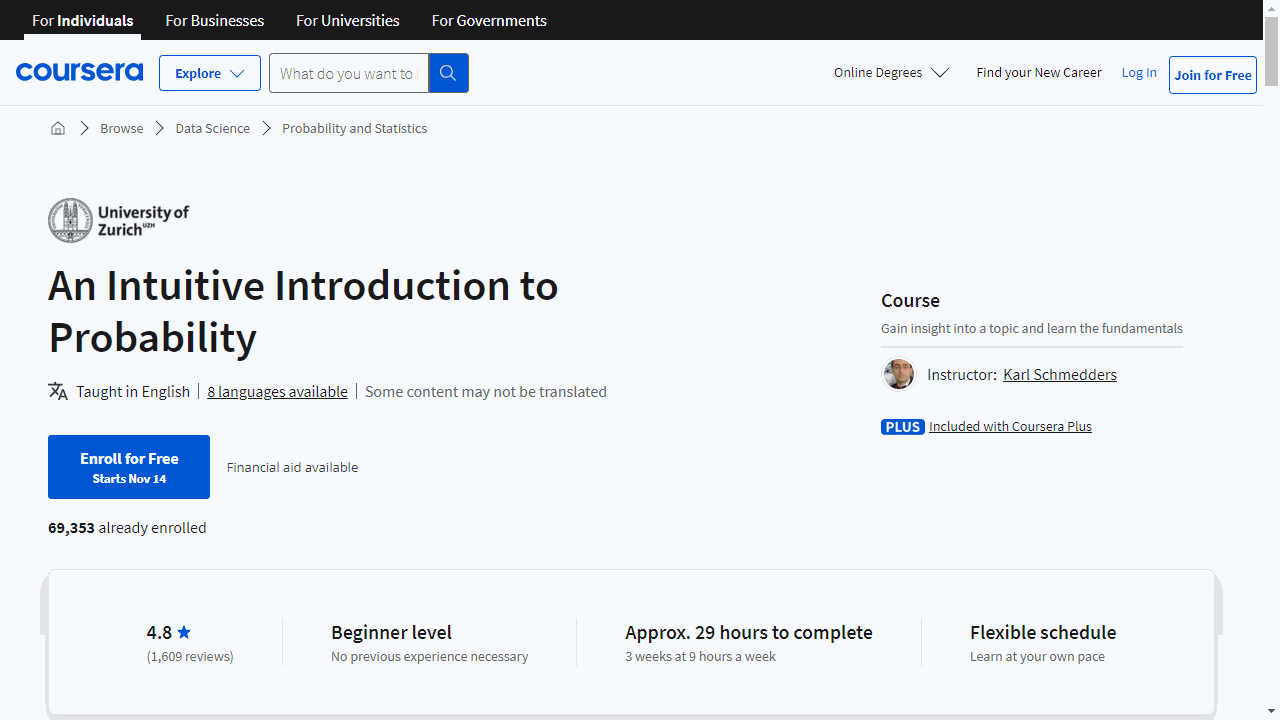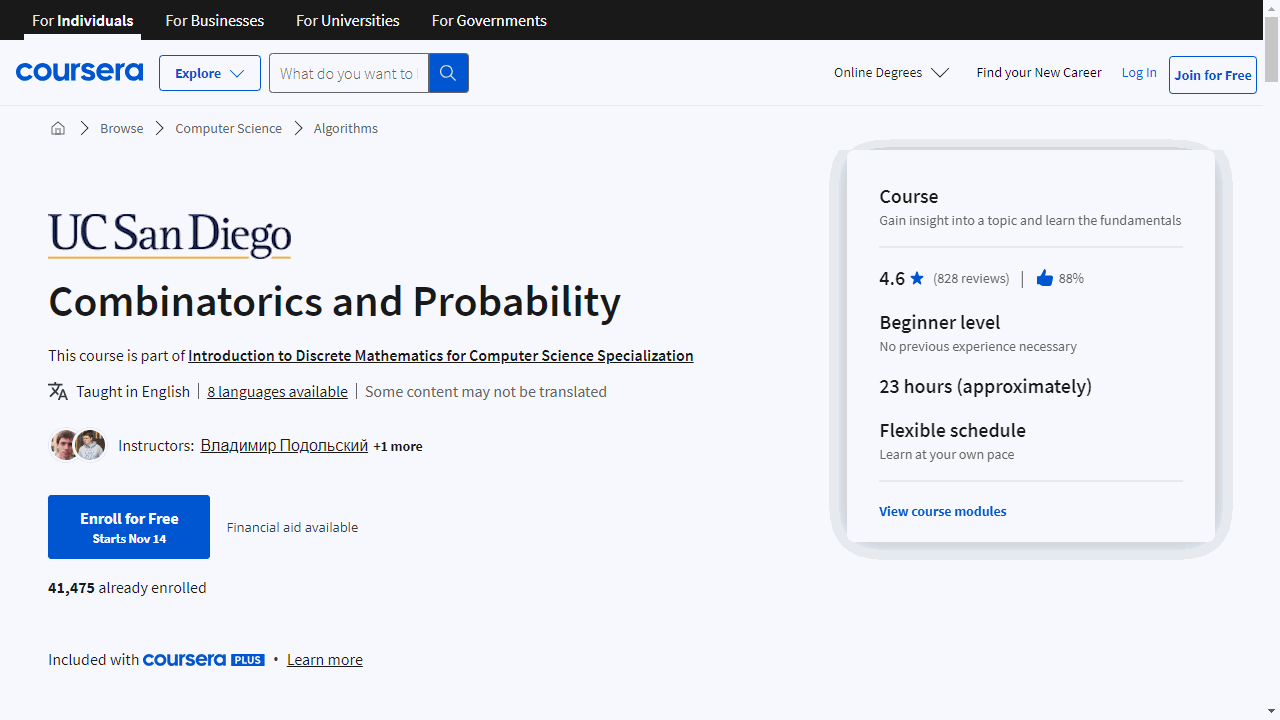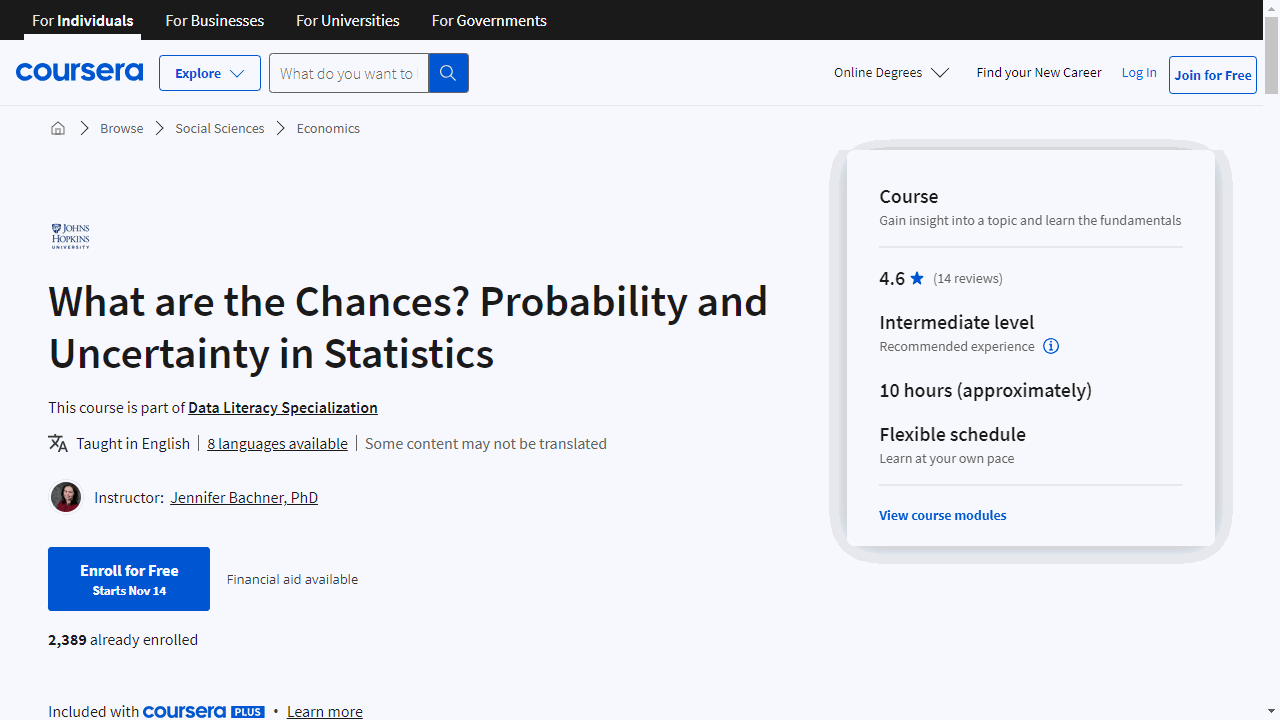Learning about probability can feel like a daunting task, especially if you’re trying to grasp complex concepts like random variables or Bayes’ Theorem.
But understanding probability is crucial in a world increasingly driven by data and statistics.
Whether you’re a student exploring data science, a professional wanting to make better data-driven decisions, or simply curious about the nature of chance, finding a good probability course can be the key to unlocking a new world of understanding.
We’ve scoured Coursera to find the best probability courses and narrowed it down to our top picks, each designed to suit different needs and learning styles.
For the best probability course overall, we recommend “What are the Chances? Probability and Uncertainty in Statistics” by the University of Amsterdam.
This course is praised for its comprehensive coverage, clear explanations, and engaging approach to complex topics, making it an excellent choice for anyone seeking a solid grounding in probability.
But if you’re looking for something more tailored to your specific interests or skill level, we have plenty more options to explore.
Keep reading to discover courses for beginners, intermediate learners, and experts, as well as courses focusing on specific applications of probability in data science and other fields.
Introduction to Probability and Data with R
This course is designed to equip you with the essential skills to understand and analyze data effectively, using the powerful programming language R, which is a staple in the fields of statistics and data science.
The course begins with the fundamentals, teaching you how to distinguish between high-quality and poor-quality data.
Understanding this difference is crucial for drawing accurate conclusions.
You’ll also learn about the design of observational studies and experiments, including how to avoid biases that can skew your results.
A key component of the course is the focus on random sample assignment.
This concept is vital for ensuring the validity of your study’s findings.
You’ll gain a clear understanding of why this process is critical in research.
Visualizing numerical data is another skill you’ll develop.
Through engaging lessons, you’ll learn to create graphs that not only represent your data but also tell a compelling story.
The course also covers measures of center and spread, helping you to summarize and describe your data’s main characteristics and variability.
Robust statistics come into play when dealing with outliers or non-normal data distributions.
You’ll learn techniques to handle such data effectively.
Additionally, the course will show you how to transform data, preparing it for deeper analysis.
When it comes to categorical variables, the course doesn’t shy away.
You’ll explore methods for analyzing and interpreting these types of data, which often represent groups or categories within your dataset.
The course then delves into the realm of inference, teaching you to use data to make informed guesses about larger populations.
You’ll start with foundational probability concepts, including disjoint events and the general addition rule.
The course also demystifies the concept of independence and provides concrete examples to solidify your understanding.
Conditional probability and probability trees are introduced as tools for navigating complex probabilistic scenarios.
You’ll also encounter Bayesian inference, a method that allows you to update your hypotheses as new data becomes available.
Lastly, the course thoroughly examines the normal distribution, a critical concept in statistics.
You’ll learn how to evaluate and apply it to real-world situations.
The binomial distribution is also covered, along with how the normal distribution can approximate it under certain conditions.
Overall, this course offers a comprehensive introduction to probability and data analysis with R. It’s structured to provide practical skills through examples and hands-on experience.
An Intuitive Introduction to Probability
This course is crafted to demystify probability, making it approachable and relevant, no matter your background.
The journey begins with the essentials: clear definitions and the core rules that form the backbone of probability.
This foundational knowledge is crucial, and the course ensures you’re well-equipped to move forward with confidence.
As you progress, the course delves into the concept of statistical independence and introduces subjective probabilities, illustrating how personal judgment can play a role in assessing likelihoods.
You’ll also encounter empirical probabilities through the intriguing example of Benford’s Law, with exercises to solidify your grasp on the concepts.
What sets this course apart is its focus on developing your intuitive understanding.
You’ll learn to navigate multiplication rules and probability tables in a way that feels second nature.
Bayes Rule, a cornerstone of probability theory, is presented in a digestible format, empowering you to revise probabilities as new information emerges.
Engaging puzzles like the Birthday Problem and the Monty Hall Problem serve not just as entertainment but as practical tools to reinforce your learning.
These examples show how probability is not just theoretical but also a fun and integral part of everyday reasoning.
The course also addresses the real-world implications of probability.
By examining the Prosecutor’s Fallacy and the case of Sally Clark, you’ll see the profound impact that a proper grasp of probability can have on lives and legal outcomes.
On the quantitative side, the course covers discrete random variables, expected value, and measures of dispersion—key concepts for anyone looking to understand data and make informed decisions.
Applications in finance, such as modeling and airline overbooking scenarios, demonstrate how probability skills can be directly applied to business challenges.
When it comes to continuous random variables and the Normal Distribution, the course provides clear explanations and practical exercises.
You’ll learn to calculate probabilities and apply the Normal Distribution to a variety of situations, ensuring you’re not just memorizing formulas but truly understanding their applications.
Throughout the course, exercises are thoughtfully integrated to encourage active learning.
This isn’t passive education; it’s an interactive experience designed to engage and challenge you.
Probability and Statistics: To p or not to p?
This course is a comprehensive journey through the world of uncertainty and decision-making, designed to equip you with the tools to navigate the unpredictable.
Starting with the intriguing Monty Hall Problem, the course immediately engages you with real-world scenarios.
You’ll explore how uncertainty affects daily decisions and the role of models in simplifying complex situations.
The course also teaches you to be cautious with model assumptions, highlighting the pitfalls of incorrect presumptions.
As you progress, you’ll delve into probability principles and encounter various probability distributions.
Think of these as different tools for different tasks – each with a specific application.
You’ll learn about expectations, which are predictions based on averages, and Bayesian updating, a method for refining predictions as new information becomes available.
Data visualization and descriptive statistics come next, where you’ll learn to organize and summarize data effectively.
Understanding measures of central tendency and spread, as well as the ubiquitous normal distribution, will become second nature.
Sampling techniques are covered in week four, where you’ll discover the importance of random sampling in avoiding bias.
You’ll also learn about sampling distributions and confidence intervals, which are crucial for making inferences about larger populations.
The final week focuses on statistical decision-making.
You’ll navigate the complexities of statistical errors and p-values, gaining insight into their significance in hypothesis testing.
The course concludes with practical applications such as decision tree analysis, linear regression, and Monte Carlo simulations, providing a toolkit for risk assessment and predictive modeling.
Throughout the course, summaries and key takeaways at the end of each week reinforce your learning, ensuring you grasp the essential concepts.
Combinatorics and Probability
This course is structured to build your understanding from the ground up, starting with a quick refresher on combinatorics.
It’s perfect if you need to brush up on the basics before diving deeper.
You’ll tackle the concept of counting games in a tournament, which is a practical skill for anyone interested in sports or organizing competitions.
The course then smoothly transitions into combinations and Pascal’s Triangle, revealing the patterns that underpin many aspects of the world around you.
The Binomial Theorem is introduced as a practical tool, not just a theoretical concept.
You’ll learn how to apply it, saving time and effort in solving complex problems.
The course emphasizes hands-on practice, ensuring that you’re not just passively absorbing information but actively engaging with the material.
As you delve into probability theory, you’ll encounter thought-provoking paradoxes, like the Galton Board, which visually demonstrates how probability works.
The course goes beyond the basics of rolling dice, exploring probability spaces and the concept of non-equiprobable outcomes, which is crucial for understanding real-world scenarios.
The section titled “Mathematics for Prisoners” highlights the practical applications of probability, showing how these concepts can have significant real-life implications.
In the realm of conditional probability, the course demystifies complex ideas like Bayes’ Theorem, making them accessible and understandable.
You’ll learn how to assess the reliability of a medical test, an essential skill in today’s data-driven world.
The Monty Hall Paradox is also covered, showcasing the surprising and often counterintuitive nature of probability.
This example will sharpen your critical thinking skills and challenge you to reevaluate how you approach problem-solving.
By the end of the course, you’ll have a comprehensive understanding of both combinatorics and probability.
You’ll be equipped to tackle a wide range of problems and make informed decisions based on your newfound knowledge.
Probability & Statistics for Machine Learning & Data Science
Looking for a solid foundation in probability and statistics tailored for machine learning and data science?
This course is a comprehensive choice that could be just what you need.
Starting with the essentials, the course introduces you to the core concepts of probability using relatable examples, like dice rolls, to ensure you grasp the basics.
It then builds on this foundation by exploring the principles of disjoint and joint events, which are crucial for understanding complex probabilities.
Independence and the birthday problem are covered early on, setting the stage for more advanced topics like conditional probability.
This is where you’ll start to see the real-world applications of the course material, preparing you for scenarios you’ll encounter in data analysis.
Bayes Theorem is a highlight of the course, presented in a way that balances intuition with mathematical rigor.
You’ll see it applied in practical examples, such as filtering spam emails, and learn how it integrates with machine learning models through the Naive Bayes classifier.
The course also delves into random variables and probability distributions, both discrete and continuous.
You’ll get a clear explanation of distributions like binomial and normal, and how to sample from them—a skill that’s invaluable for predictive modeling.
As you progress, you’ll encounter various ways to visualize data, from box-plots to violin plots, which are essential for exploratory data analysis.
The course also introduces covariance and correlation, helping you understand the relationships between variables.
In the latter weeks, the focus shifts to sampling techniques, the law of large numbers, and the central limit theorem.
These concepts are the bedrock of statistical inference and will enable you to make informed decisions from data samples.
Point estimation and maximum likelihood estimation are thoroughly explained, providing you with the tools to infer population parameters from sample data.
The course also revisits Bayes Theorem in the context of regularization, showing its relevance in preventing overfitting in machine learning models.
The final week brings everything together with practical applications.
You’ll learn about the Z distribution, how to calculate confidence intervals, and the nuances of hypothesis testing.
The course concludes with t-tests, including practical applications like A/B testing, which are commonly used in machine learning to compare models or strategies.
This course offers a well-rounded education in probability and statistics with a clear focus on applications in machine learning and data science.
It’s designed to give you a deep understanding of the subject matter without overwhelming you with complexity.
What are the Chances? Probability and Uncertainty in Statistics
This course is designed to equip you with a deep understanding of probability, preparing you to navigate the uncertainties that statistics often present.
You’ll delve into the core concepts of probability, learning the foundational definitions and axioms.
This section ensures you have a clear grasp of the basic principles that will support your entire learning experience.
As you move forward, the course takes a practical turn with permutations and combinations.
These topics are essential for understanding how to count and arrange items in various ways, a skill that’s invaluable in many real-world applications.
Conditional probability and independence are up next, teaching you to calculate the likelihood of events based on existing conditions.
This segment is akin to solving a puzzle, where each piece of information helps you see the complete picture more clearly.
You’ll also explore random variables and probability distributions, which are the backbone of predicting outcomes and understanding event probabilities.
This knowledge is crucial for anyone looking to analyze data effectively.
The course then introduces you to the normal distribution, a concept that appears frequently in statistical analysis.
You’ll learn why it’s significant and how to apply it to interpret data accurately.
Large sample theorems come into play, offering you tools to make educated inferences about vast populations from smaller samples.
This is particularly useful when dealing with extensive data sets.
Bias, consistency, and the standard error are covered to ensure your statistical predictions are reliable and not skewed by inaccuracies.
These concepts are vital for maintaining the integrity of your analyses.
You’ll then dive into confidence intervals and hypothesis testing, where you’ll learn to quantify the certainty of your statistical estimates.
The course also guides you through the practical aspects of implementing hypothesis tests, including the examination of regression coefficients.
To round out your education, the course addresses common pitfalls in hypothesis testing and discusses the margin of error in polls, providing you with a comprehensive view of the challenges statisticians face.






